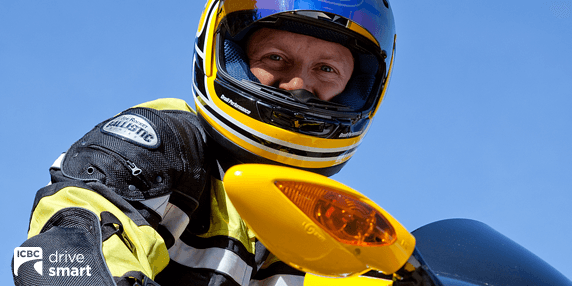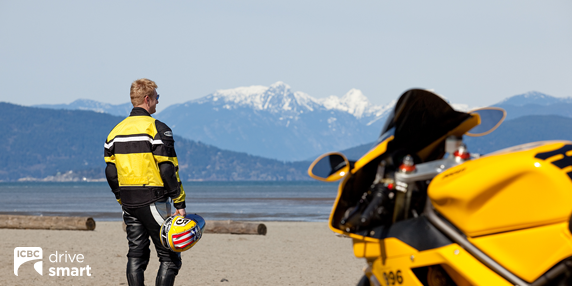Newsroom
Motorcycle safety tips for new and experienced riders
June 12, 2019

The weather is at its finest – is there any better way to enjoy the sunshine and blue skies than on the seat of your motorcycle?
Unfortunately, motorcycle crashes in B.C. peak in the summer as warmer weather and conditions bring more riders onto the road. You can reduce your chances of crashing or being seriously injured by following these safety tips.
Train or re-train
If you're new to riding a high-powered two-wheeler, you'll first need to get your motorcycle licence. The steps to getting a motorcycle licence depend on whether you already have a B.C. driver's licence. Find out more about the process on our website.
Learners can consider taking rider training from professional schools. Many returning riders assume they can pick up where they left off a year, two, or three ago only to discover they're not quite up to the challenge. Smart returning riders may decide to take a course also.
Take it easy, rider
Don't ride more bike than you can handle. Choose a motorcycle that fits your experience and skill ability. It's important to be familiar with the handling characteristics of your ride and be able to safely manage it. Learn how to accelerate sensibly and safely; smooth acceleration is key, as is knowing how your bike will respond to an action before you take it.
Don't vroom off just yet
Before jumping on your shiny chrome steed, take some time to reacquaint yourself with the basic skills. Find an empty parking lot or a quiet back street and spend some time practicing low-speed manoeuvers and emergency braking. Remind yourself what it feels like to ride on two wheels instead of four.
Careful on the brakes
Choose a motorcycle with an anti-lock braking system (ABS) – these are proven to reduce the risk of being in a fatal crash.
Mastering how much brake force to apply, and how quickly, is important to prevent you from losing control of your motorcycle.
Gear up, not down
With the protective gear, that is. Not only does safety gear make you look like a pro rider, but it also lessens your chance of sustaining serious or fatal injuries in the event of a crash. Most crashes involve falling off your motorcycle, and street clothes won't protect you from the loss of skin, muscle, blood, or worse.
Helmets – It pays to be hard-headed
The most essential part of your riding gear – legally and safety-wise – is your helmet. Its primary job is to protect against head injuries and fractures, but we recommend you choose one with a full-face visor to protect you if you plant a facer, not to mention it guards you from watery eyes, flying debris and bugs (yuck).
All motorcycle riders and passengers must wear helmets that meet safety industry standards – it's the law in B.C. Follow our guidelines on choosing gear that provides the most protection for you.
And don't forget that passengers need the same protection, too.
Ready to hit the road?

Keep your eye on the prize
Always look in the direction of where you want to go. Prior to reaching a curve, plan your path through it. Reduce your speed and adjust your lane position. If you need to brake, try not to do it while in a curve – remember to straighten up first.
Don't get distracted by things like your phone or GPS. Keep your eyes on the road and focused on your surroundings. This goes for drivers, too. Distracted driving and failing to yield the right-of-way are the top contributing factors for drivers in police-reported crashes with motorcyclists.
No need for speed
Manage your speed to leave ample time to stop or steer out of a vehicle's path.
Be alert, especially at intersections
A common scenario in motorcycle crashes is another vehicle turning left in front of an oncoming motorcycle at an intersection. Drivers, scan intersections and look carefully for motorcycles. When turning left, look for oncoming riders.
Motorcyclists, pay absolute attention before and at every single intersection. This includes street corners, alleys, parking lots, drive-thrus and gas stations – especially where oncoming traffic is waiting to turn left. Reduce your speed so you'll be able to stop if necessary. Adjust your lane position so you'll have an escape path if you need it.
Be keen, be seen
Motorcycles are smaller than passenger vehicles, they're harder to see and don't offer the protection of a frame, seatbelts or airbags. As a driver, you can only see motorcycles when you really look for them. Stay alert and yield right-of-way appropriately.
Motorcyclists can increase their visibility by wearing brightly colored or reflective clothing, or by putting reflective strips on their helmet and the backs of their boots. If your jacket is black, consider wearing a safety vest over it while you ride.
Don't ride in anyone's blind spot. Ride up ahead of them or far enough behind so if they suddenly switch lanes without signalling, you won't get hit. Never assume drivers have seen you or will give you the right-of-way; they may not accurately judge your distance or speed.
Lane splitting (riding between moving vehicles) and filtering (moving forward between stopped vehicles) are illegal in B.C.
Send the right signals
Before changing lanes, all road users should signal their intention, check their mirrors and shoulder check. As a motorcyclist, in addition to signaling, you can use turning your head as an alert to drivers around you that you're going to be moving or turning. Remember to cancel your signal indicator after changing lanes or completing a turn. They don't switch off automatically.
Bringing others along for the ride
A passenger will affect how you ride due to the extra weight and movement so be prepared to adjust for the change by taking a practice ride in a safe place. To carry a passenger, your motorcycle must be equipped with passenger foot pegs or footboards, and the passenger must keep their feet on the pegs or boards while seated on the motorcycle. If their feet don't reach the foot pegs, it's illegal for them to ride. It's a good idea to do some low-speed practice with passengers in an empty parking lot before heading out on the road.
Ride on
Motorcycle riding takes focus, patience and practice. When you're out on the road – be safe, have fun, and enjoy the ride.
